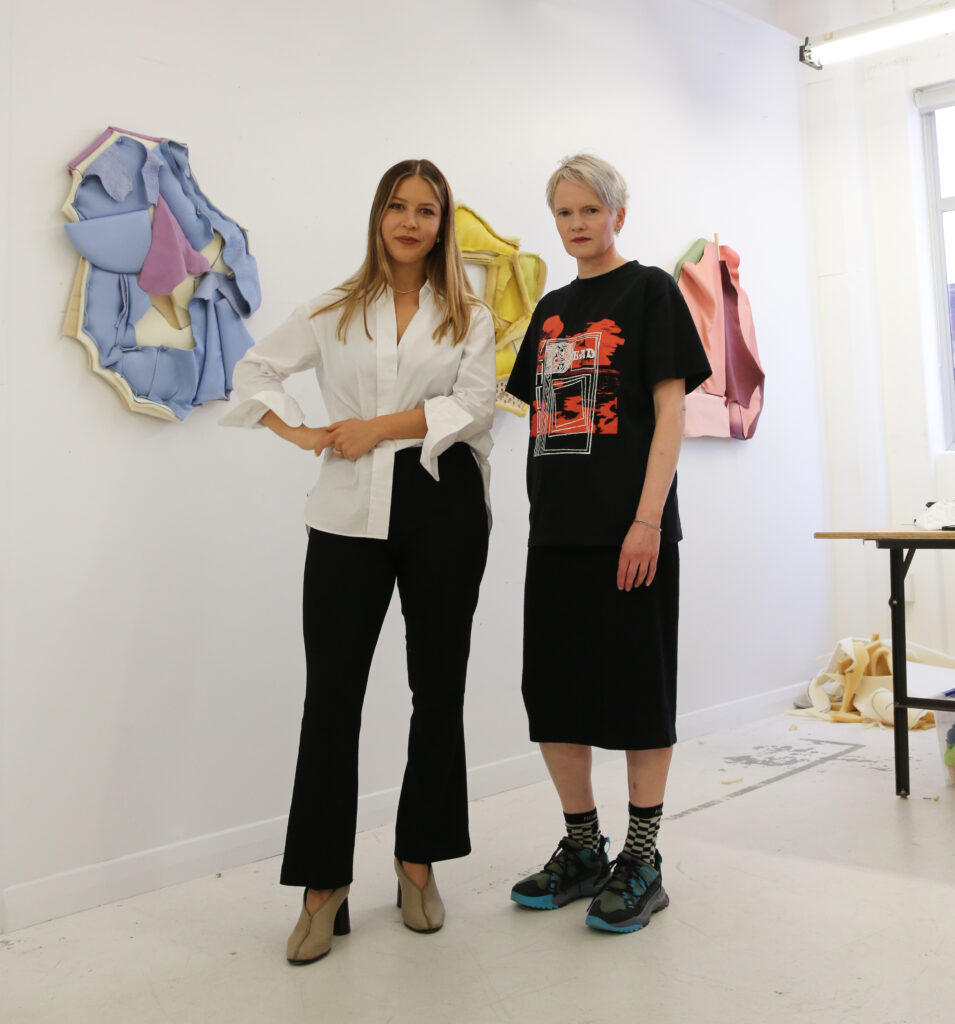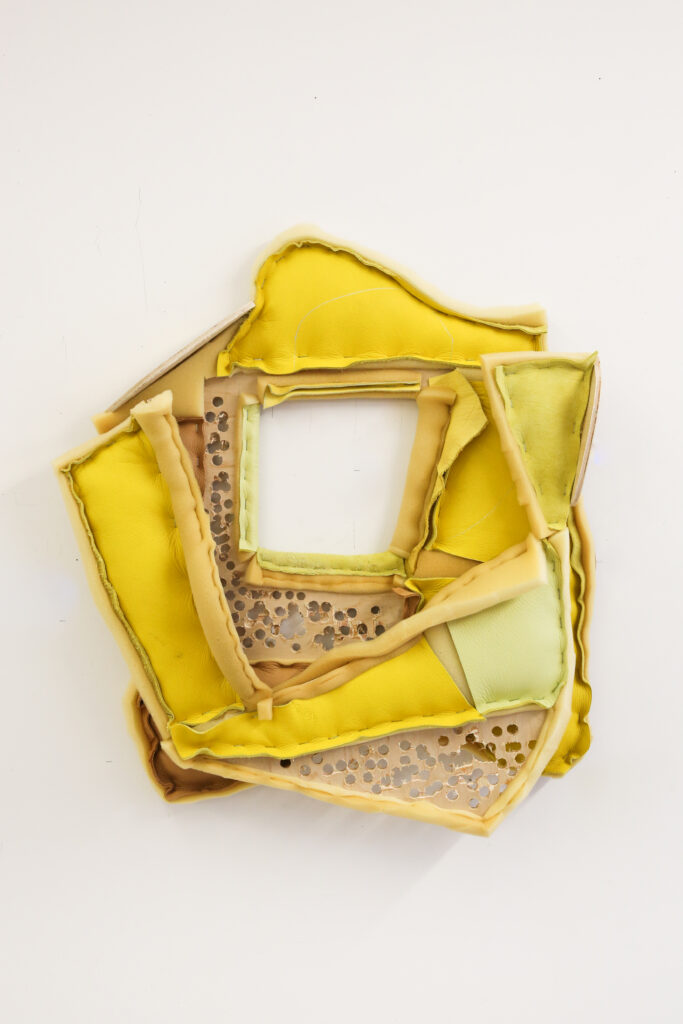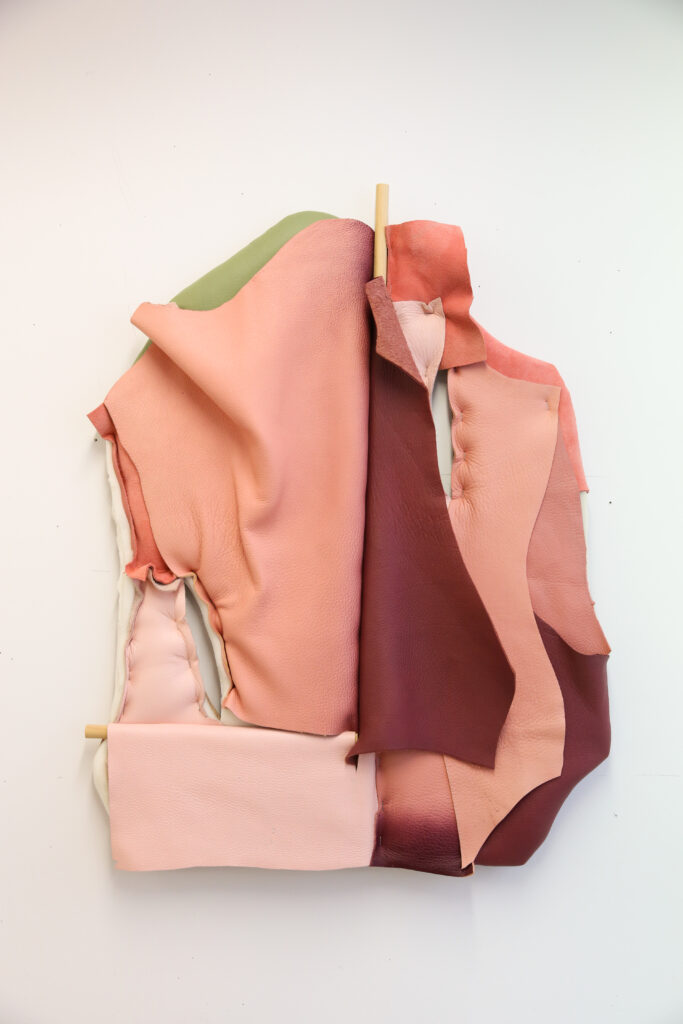
Regeneration is at the core of local luxury leather goods brand Yu Mei. The majority of its handbags and wallets are made from South Island-farmed Deer Nappa — a byproduct of the venison industry — and the brand is constantly looking for ways to minimise waste and repurpose their offcuts. One example of this is Yu Mei’s annual Archive Sale, which sees it turn offcuts and preloved bags into fresh leather goods to sell at the event, with all proceeds going to the Wellington City Mission.
Another example is Yu Mei’s latest collaboration with Kirsty Lillico. Kirsty is an artist based in Te Whanganui-a-Tara, represented by Scott Lawrie Gallery. For this body of work, titled Rumpus, Kirsty transformed Yu Mei’s production offcuts from the past four years into wall-mounted upholstered reliefs, which will be on display at Yu Mei’s Wellington retail Lounge at 85 Victoria Street in celebration of the Threads Textile Festival.
We asked Jessie to interview Kirsty about the project, how the concept of Rumpus came about, and what it was like for Kirsty working with leather for the first time.
JW: Tell us a little about Rumpus — how did the idea and name come about?
KL: Rumpus is a series of upholstered paintings. I created supports out of plywood, covered them with foam, then stapled Yu Mei’s offcuts onto them. The name Rumpus comes from ‘rumpus room’. Leather is a material I’d never used before, so my process was very much about experimentation and play, and because architecture is another interest of mine, I was also thinking about interior spaces that relate to the materials.
JW: What’s your usual process when working with material, and how did that differ from working with deer nappa?
KL: I usually spend a long time looking at what a material wants to do naturally, like seeing how it wants to hang. In the past, I’ve used quite robust materials such as carpet, which really have a mind of their own, but leather’s quite different — particularly this [deer nappa] leather, which is really soft. So I wanted to lean into that, and utilise things like how it can stretch. The luxuriousness of the leather also influenced my process in terms of craft, for example, the choice to use a material like foam, which is so ephemeral — it doesn’t age well at all. It’s the same with plywood — it yellows and goes brittle over time. There’s something in me that decided to use those materials in reaction to the luxuriousness of working with leather.
JW: What about the offcuts? How did you find working with those?
KL: I’ve always been drawn to what I guess you’d call ‘found’ shapes, so when the offcuts came to me in all the shapes that had been left over from producing bags, I chose to leave them as they were, rather than cut into them. That meant the shape of the artworks was determined by the natural shape of the skins.
JW: As someone who doesn’t eat animal products, were there any tensions that arose for you when working with Yu Mei’s leather?
KL: I definitively debated whether I should participate in this collaboration. Wool carpet isn’t vegan either, but working with the actual skin of an animal was pretty confronting. Then again, Yu Mei is working with something that’s a ‘byproduct’ of the venison industry, and then I’m working with waste from that process by using
the offcuts. On one level, that’s good — it’s utilising every part of the animal, like nose-to-tail dining — but it’s also commodifying a dead animal. I had a strong impulse to ‘de-luxurify’ the material somehow. I didn’t want to use sewing or any craft technique that was going to elevate it further. Instead, I wanted to interrupt the semiotics of these luxury goods, with an awareness that my work was going to be displayed in Yu Mei’s store.
JW: As a Wellington artist predominantly working with textiles, what does Threads festival mean to you?
KL: It’s nice to be included. I think there’s been a resurgence of interest in textiles, and I’m happy that artists who work with them are now included in the art conversation, rather than the craft conversation, or that there’s an acknowledgment that we can be in both — those hierarchies aren’t there as firmly as they used to be.
JW: What have you learned or gained from this process?
KL: I think it’s pushed my practice forward into a different area. Leather lends itself to a sculptural process because it has a robustness to it, but because of those ethical questions, I hadn’t investigated it further. But that’s the fantastic thing about collaboration — it offers you space to grow what you’re doing in a way that wouldn’t have happened otherwise.



Rumpus is on display at the Yu Mei Lounge, 85 Victoria Street, Te Aro, Wellington. Read more about the collaboration in the Fashion Quarterly autumn issue, available in all good newsagents, supermarkets, and online from March 21st 2022.










